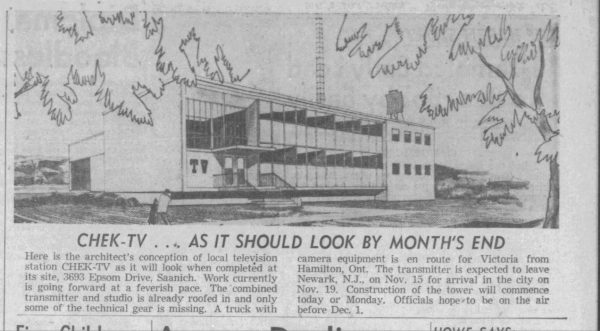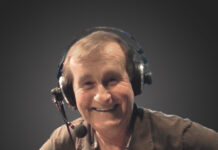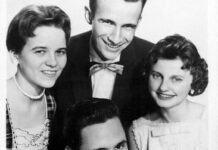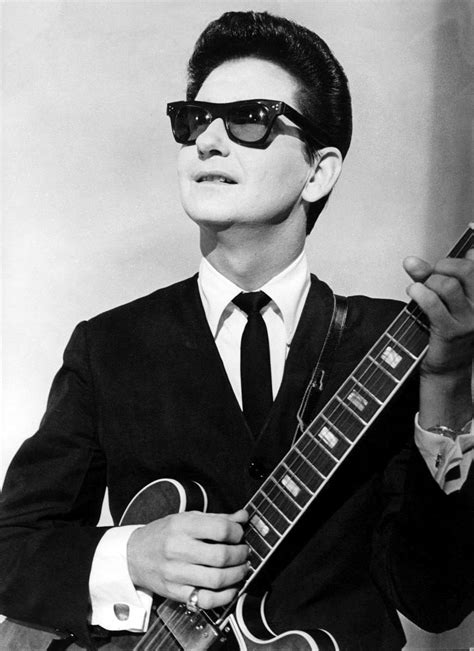
Written by Drew Snider
Victoria Times Colonist
Published by Victoria Times Colonist
Originally Published: March 7th, 2004
Author describes the coming of local television to southwestern British Columbia.When television first came to Victoria, viewers recognized local actors, dancers and singers – and even classmates from school
This is another in a periodic series on the first half-century of TV in B.C.
There is an expression that strikes fear into the hearts of radio management types around Victoria: “offshore tuning.”
Victoria radio listeners are in a unique position: they can bring in radio stations from Seattle and Vancouver just as well as they can tune in stations from their own backyard. That makes it somewhat fitting that Victoria’s first television appearance was in an “offshore” setting: more than that, it was off country. KVOS had beaten CBC to the southern B.C. market by about six months, and in 1954, just as CBUT was breaking in its studios in the converted Packard showroom on West Georgia Street, the Bellingham station was first to show Victoria live to TV-land.
The Colonist at the time described a combination of filmed interviews and performances by local entertainers, beamed by microwave to the Channel 12 transmitter on Orcas Island. The broadcast survived a breakdown in the microwave link that was restored just before air time, and a downpour that caused a flood in the makeshift station.
There were promises of more “Victoria exposure” on Channel 12, but it would be another two years before that was guaranteed, with the opening of CHEK TV.
CHEK represented “the next level” of broadcast enterprise for Dave Armstrong, who had started by selling time at CJVI Radio, then set up his own radio station, CKDA, in 1950. As a CBC affiliate, the station ran a lot of programming from the Mother Corp, but Victorians got to see a lot of themselves, too. Did you sit on the floor in front of Romper Room, with Joy Perkins and Shirley Jefferson? Did you tap your feet to Club 6? Or watch afternoon cartoons with Bob McGavin and his St. Bernard friend, Shandy?
And how about The Noon Show, which ran for the better part of three decades? It began life as The Willie Taylor Show hosted by (you guessed it) Willie Taylor, whose husband Doug was Armstrong’s second-in-command. In 1961, Ida Clarkson overcame her wariness of the “one-eyed box” to take the show over and make it hers — and ours. She had co-hosts — newscaster Andy Stephen at first, and then Dave Roegele — but there was little doubt that this was Ida’s Show.
Hosting the live, one-hour show meant Ida got her hair done every day, but it was hardly a “superstar gig. Nobody did just one thing,” she recalls. “We didn’t have much staff. I was hired as copy writer and copy editor, and I didn’t bother telling them I knew how to thread a projector, because I’d have had to do that, too.”
Bob Aylward, for example, was a celebrity for hosting Club 6, where local teens got to try out the latest dances live every afternoon, but he also ran master controlling and did the voice-over announcing.
In a time when stations like The New VI have technology where changes can be made at the click of a mouse (that’s the theory, anyway), it’s easy to forget how labour-intensive television was in those days. Al Scherr, who worked in the traffic department in the 1960s, recalls that any filmed productions had the program, station breaks and commercials spliced together onto one big reel.
“Anytime there was a change in a commercial or something,” he says, “we’d have to run down, take out the film, find the spot, splice out the ‘old’ segment and splice in the new one.” CBUT’s Andy Snider was another who did multiple duty before becoming a public-affairs producer (Klahanie ran for 13 seasons). On some occasions, he’d be wrangling chickens and baby goats for a Christmas special, other times he’d screen movies “which were so old, Walter Brennan got the girl.”
No matter: it was an exciting new medium and audiences had a reason not to tune “offshore”: they were seeing themselves. Clarkson says she and her “CHEK-mates” prided themselves on providing far more local content than KVOS ever did.
“Actuality” shows like Club 6, The Noon Show and the newscasts showed Victorians a lot of themselves, but entertainment largely came from Vancouver. And unlike the mind-set of more recent years that “out-of-town” is better than “home-grown,” CBUT built itself around the talent at hand.
There was a lot of it. Robert Clothier, Peter Mannering, Dorothy Davies, Joy Coghill, Daphne Goldrick and Ted Greenhalgh were established on the local stage; so were singers Eleanor Collins, Ernie Prentice, Betty Phillips and Lorraine McAllister; Lance Harrison, Dal Richards, Fraser MacPherson, Chris Gage and Pat Trudell were among the musicians. The shows included Parade, Bamboula and a light-hearted public-affairs show, Almanac, featuring Bill Bellman, Al Miller and Bob Fortune.
Drama production talent came from a range of sources. Jack Thorne came with a theatre degree from Northwestern University outside Chicago: he specialized in children’s shows, and came up with Tidewater Tramp, the adventures of two children on a coastal freighter visiting B.C.’s ports; Timothy T., which told stories using Balinese shadow puppets; Hidden Pages dramatized portions of books kids could find in the library.
Daryl Duke had just graduated from UBC with a degree in poetry after studying under Earle Birney. Someone at the National Film Board liked his visual imagery and brought him in to make films. When TV beckoned, Duke went home to Vancouver.
Phil Keatley knew next to nothing about TV drama production except for some brief glimpses as an actor on BBC TV in the early ’50s. He joined the team in 1957 and learned quickly what the producer did after he’d left the studio and “gone running upstairs.” But he was soon filling a slot a week with live drama, telling stories to British Columbians about British Columbians.
One of the most memorable grew from a dare. Newspaperman Paul St. Pierre, who hosted an early “outdoors” program, told Keatley’s mentor, Frank Goodship, that he could write a better script than one Goodship had just produced. Window at Namko — which Keatley describes as a “slight” story about a retired banker from Toronto battling B.C. liquor laws to have a picture window in his hotel in the Chilcotin — got more audience response than anything else. That led to Cariboo Country, which Keatley produced. Aside from spawning a Disney movie and launching Chief Dan George, that series broke new ground by telling one subset of British Columbians what life was like for another subset of British Columbians.
Indeed, the coming of local television and its studios to southwestern B.C. did something no other medium had been able to do: it gave people a view of what they had in their own backyard. Whether it was watching Ida sewing with Marion Sawyer or arranging flowers with Norma Fitzsimmons, spotting your classmates on the Club 6 dance floor, or watching entertainers you’d also seen at your local theatre or nightclub, television gave people access to something of their own — not made thousands of miles away, or syndicated from 20 years in the past.
“We had our own performers on camera with our own people producing,” says Daryl Duke, “and when you hear people prattle on about the ‘500-channel universe ‘ … remember that the greatest thing we can do (in TV) is to protect a society ‘s memories. As we had to protect memories in 1953, we still have to in 2004.”








Thanks for this article Drew. I worked at CJVI when Art Hall who was the Operations Manager at CHEK TV hired me first on a part time basis at CHEK as a switcher and Audio booth announcer, then when Bob Alyward left to take up a position with Victoria Cablevision, I took over hosting duties as the new Club Six host, eventually renaming the show ‘Get It On’ with Mike Easton which was featured each week on Channel Six.